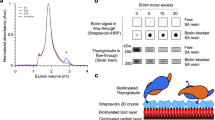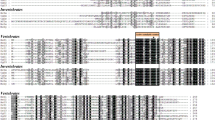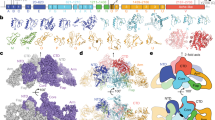Abstract
REGRESSION of the tadpole tail is under direct control of the thyroid hormones and provides a system for study of their mechanism of action1. In this system triiodothyronine (T3) is two to five times as active as thyroxine (T4) in causing tail regression2,3. Studies of the binding of 125I-T3 and 125I-T4 after incubation of hormone with sliced tailfin tissues have revealed high-affinity, saturable binding sites in the cell nucleus4—a maximum of 1,500 and 800 sites per nucleus for T3 and T4, respectively. (Similar results have been obtained with tadpole liver cells5.) The dissociation constants for T3 and T4 were almost identical (10−10 M). These results suggest that in amphibians the maximum number of binding sites rather than the affinity constant correlate with the biological activity of T3 and T4. In mammals, however, specific high-affinity binding sites for the thyroid hormones were found in nuclei6–8 and correlate with the affinity constant.
This is a preview of subscription content, access via your institution
Access options
Subscribe to this journal
Receive 51 print issues and online access
$199.00 per year
only $3.90 per issue
Buy this article
- Purchase on Springer Link
- Instant access to full article PDF
Prices may be subject to local taxes which are calculated during checkout
Similar content being viewed by others
References
Frieden, E., and Just, J., in Biochemical actions of hormones (edit. by Litwack, G.), 1–52, (Academic, New York, 1970).
Wahlborg, A., Frieden, E., and Bright, C., Endocrinology, 75, 561 (1941).
Frieden, E., and Yoshizato, K., Endocrinology, 95, 188 (1974).
Yoshizato, K., Kistler, A., and Frieden, E., Endocrinology (in the press).
Kistler, A., Yoshizato, K., and Frieden, E., Endocrinology (in the press).
Samuels, H. H., and Tsai, J. S., Proc. natn. Acad. Sci. U.S.A., 70, 3488 (1973).
Surks, M. I., Koerner, D., Dillman, W., and Oppenhimer, J. H., J. biol. Chem., 248, 7066 (1973).
Degroot, L. J., and Strausser, J. L., Endocrinology, 95, 74 (1974).
Derby, A., J. exp. Zool., 168, 147 (1968).
Taylor, A. C., and Kollros, J. J., Anat. Rec., 94, 7 (1947).
Burton, K., Biochem. J., 62, 315 (1956).
Scatchard, G., Ann. N.Y. Acad. Sci., 51, 660 (1949).
Just, J. J., Physiol. Zool., 45, 143 (1972).
Tata, J. R., Nature, 227, 686 (1970).
Griswold, M., Fischer, M., and Cohen, P. P., Proc. natn. Acad. Sci. U.S.A., 69, 1486 (1972).
Usuku, G., and Gross, J., Devl Biol., 11, 352 (1965).
Author information
Authors and Affiliations
Rights and permissions
About this article
Cite this article
YOSHIZATO, K., FRIEDEN, E. Increase in binding capacity for triiodothyronine in tadpole tail nuclei during metamorphosis. Nature 254, 705–707 (1975). https://doi.org/10.1038/254705a0
Received:
Revised:
Issue Date:
DOI: https://doi.org/10.1038/254705a0
Comments
By submitting a comment you agree to abide by our Terms and Community Guidelines. If you find something abusive or that does not comply with our terms or guidelines please flag it as inappropriate.



